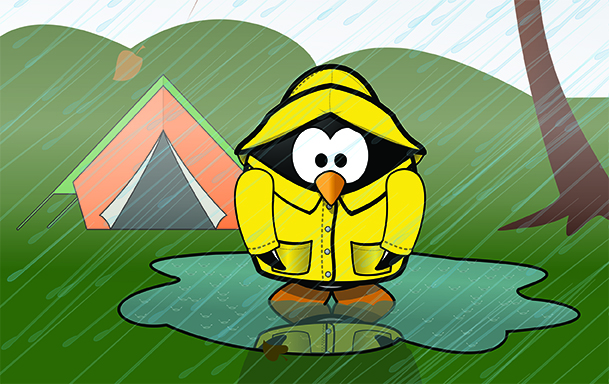
Camping in Bad Weather
By Ellie Matama
According to Statista.com, 45.07 million people in the USA– 14% of the general population – went camping in the spring of 2015. It goes without saying that camping is one of the best recreational activities that you can do outdoors – on your own or with other people. So, why not join the crowd?
Oh, wait! You will need to have all the gear in place before you go out into the wild. Mother Nature is majestic and glorious. But she can also show her fury in the worst ways possible. Whether you intend to spend a few hours outdoors in the wild, or several days away from civilization, you need to be prepared.
What should you carry with you as you head outdoors? How can you prepare yourself to withstand Mother Nature’s fiery displays?
Backpack
Backpacks are an important aspect of recreational travel. According to reportlinker.com:
- The backpack industry in the US is worth $2.7 billion.
- The UK backpack market is worth an additional $100 million.
What you carry in your backpack may end up saving your life when you become stranded in the wild.
Your backpack of choice should be waterproof. That way, if there is a storm, your stuff will remain dry. The ideal backpack size will range from 40-80 liters.
If you intend to stay outdoors for several hours, a 40-liter backpack may suffice. If you want to stay overnight at your camping ground of choice, you need a bigger rucksack of about 40-65 liters. Backpacks with a capacity of 65-80 liters would best suited for camping trips that stretch for several days and nights.
A medium-sized backpack can hold items such as a sleeping bag or a small tent. Remember though that the biggest rucksacks need to have padded hip belts to offset the heavier weight.
Consider buying brands such as Fox Outdoor and Shreck among others. Do check out for reviews and ratings before you choose the right rucksack for your camping needs.
Shelter aka Tent
Based on a 2013 statista.com report, 63% of survey participants stated that a camping tent was one of the most important items for any camper. This should not come as a surprise at all.
The last thing you want is for Mother Nature to whip up a storm when you have no shelter. The rain and the cold may end up giving you pneumonia. Freezing temperatures may cause hypothermia. If you are far away from civilization at that point, you would be in trouble.
You should therefore take time to shop for a good-quality tent. Popular brands include NTK Global. Check out the bestseller lists on stores like Amazon and choose accordingly.
Fire and Heat Equipment
When nature goes haywire, you will almost always need heat to keep you warm. You need some form of fire starter and matches or lighters. You do not have to worry about wood. In the wild, wood is everywhere. You just have to get some before everything gets wet. That said, you should consider carrying a propane gas stove for cooking purposes.
You must ensure that your fire-starting equipment is enclosed in waterproof containers. Otherwise, you will not be able to light anything when you need heat the most.
Direction-Finding Tools
People get lost when camping. The key is to know how to find your way back into civilization.
If geographical studies were never your strong suit, consider buying a GPS system. It will enable you locate where you are when Mother Nature makes it impossible to tell left from right. Take time to learn how to use it BEFORE you go camping.
A map of the area you intend to camp out in is also necessary. Also take a compass with you to determine direction. Both of these pieces of equipment make for a good plan B.
Take note though: it’s not enough to have a map if you do not know how to read it. Before you set out for your outdoors trip, familiarize yourself with various landmark geographical features. Also take a pencil with you to mark the landmarks you pass by. Doing so will help you find your way if you get lost.
Protection Clothing and Other Items
Nature is very unpredictable; so, never make assumptions regarding how hot or cold it will be by the time you go back home after camping out.
Buy the right kind of shoes for the terrain you will be traversing. High heels and casual are a no-no. Your hiking shoes need to be sturdy enough to protect you as much as possible from snake bites and thorns. Your shoes should also have a surface that enhances friction to help you navigate slippery terrains. In addition, they should also keep you warm in the worst cold.
Take a change of clothing that includes sturdy pants, warm socks, long-sleeved shirts, and heavy jackets with hoods. Should you get wet, you should be able to change into something dry to keep you from getting sick.
A hat will keep you protected from extreme heat especially if you have very sensitive skin; and so will sunglasses. Do not forget sunscreen and insect repellant too.
Lighting Equipment
Always carry a flashlight, even if you intend to stay in a lighted campground. You just never know. Storms tend to disrupt everything, which includes power. The last thing you want is to end up alone in the dark.
If you intend to spend several days in the outdoors, carry extra batteries.
Food and Water
If you have taken survival training, foraging for food in the wild would not be that big of a problem. However, when Mother Nature is raging, there is not going to be much time for that.
Always carry extra food supplies for camping. Carry drinkable water as well. A means of purifying water, which may include tablets, will also come in handy when your water supply runs out.
Dehydrated and canned foods are great for camping. Your food supplies can therefore include beef jerky, dehydrated vegetables, tinned fruits, pasta, energy bars, and canned cereals like beans. Anything that is light, easy to store and cook is ideal. Meals ready to eat are great for emergencies.
A Dutch oven is a one-in-all item that will be handy whenever you want to cook or bake. Consider carrying one if you intend to stay outdoors for many days on end.
Comfort Items
Even when Mother Nature rages outside your tent, you would want to be as comfortable as possible. You therefore need to pack a sleeping bag and a thermal blanket. If you have space for a thin pillow, pack that too. Tissue paper and lip-balm are also a necessity, don’t you think?
Emergency Supplies
You can never be too prepared for Nature in all her glory. So take everything you think you would need in an emergency – and then some.
Always carry a first aid kit. It should contain bandages, snake bite kit, tweezers for splint removal, antibiotics, antibacterial ointment, pain-relief medication, and antihistamines for allergies, safety pins, first-aid manual and oral rehydration salts.
Other emergency supplies include a whistle, phone charger, multi-tool knife, and a strong rope, a roll of duct tape and soap. Also carry your fully-charged phone. For group travel, a two-way radio will be handy to have. Consider also carrying an emergency flare or two to signal your position if you end up hopelessly lost.
This list of what to carry with you when camping out is by no means conclusive. Mother Nature is very unpredictable. All you can do is buy everything on your preparation checklist and then hope for the best. Double-check, then triple-check everything on your list of items that you need for camping. Who knows? When everything is said and done, you may have spectacular once-in-a- lifetime pictures as a testimony to your survival of Mother Nature’s impressive displays!
Ellie Matama Is a Kenyan-based freelance writer that has been writing since 2011. When she is not busy writing, she fantasizes about and makes plans to travel around the world. She also watches cooking shows, and reads novels.



